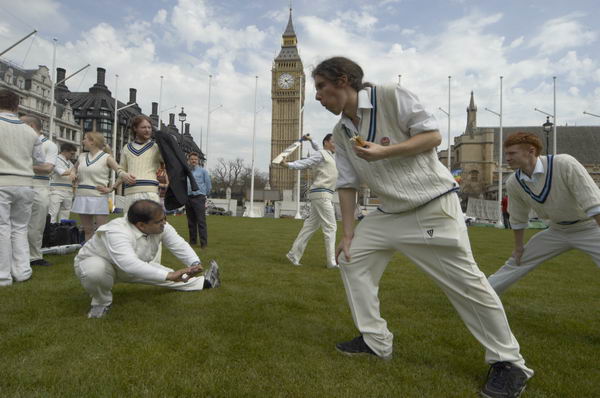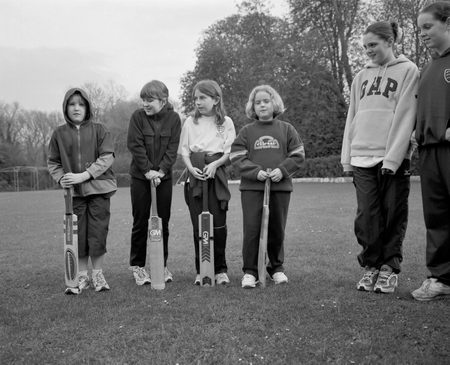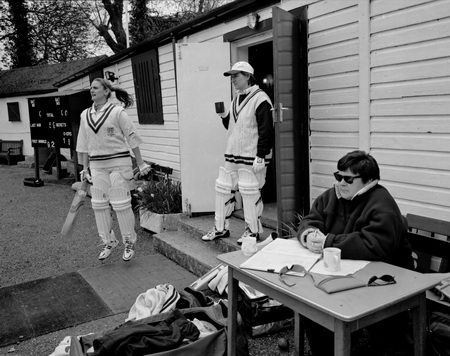Last night I visited the holy of holy for many, the inner sanctum of the world of cricket, the Long Room at Lords. Even for someone with so little interest in the game as me it was an interesting experience, and there in a glass case was a small terracotta urn along with some larger and shinier trophies.
As the name suggests it is a fairly long room, and did look quite large when we were some of the first to arrive – our rush hour bus had taken rather less time than the Transport for London web site’s rather pessimistic forecast. But it felt fairly crowded when the other 290 or so had arrived. It’s a pleasant enough space, and but for the fact it was dark would have given us a good view of the pitch with its unlikely looking stretched out lollipop media centre by Future Systems at the opposite end. But for lovers of cricket, this is the spiritual home of the game and the MCC, the Marylebone Cricket Club, “the guardian of both the Laws and the Spirit of Cricket.”
It’s also more surprisingly a part of the London 2012 Olympics, despite cricket not being an Olympic sport (presumably because countries such as America and France have never managed to understand the rules.) Instead they are shooting out the archery here.
We were there not for cricket but for the launch of a book written by a friend about “the first garden suburb“, the villas, many still standing, built a hundred years before the Garden Suburb movement on the extensive Eyre brothers estate of St John’s Wood – where the world’s most famous cricket ground was built on the site of a pond. Mireille Galinou‘s ‘Cottages and Villas – The Birth of the Garden Suburb‘, published by Yale University Press (ISBN: 0300167261) and based on several years of her work on the Eyre archive looks a fascinating and superbly illustrated study of the building of the area and the people who came to live there.
The MCC moved to St John’s Wood – their third ground – in 1814, and the new pavilion we were in was built in 1826 after the previous one burnt down Many of those who attending the launch were local residents, members of the St John’s Wood Society, founded to promote and conserve their unique area (I don’t think they included any of the pop stars and Russian oligarchs who now live there but keep themselves to themselves in their deeply dug basements behind high gates and security cameras) and the books were selling like hot cakes – I saw one man leave carrying four of them.
Fortunately I hadn’t gone there to take photographs (I commiserated with the man who had), as when I took my camera out of my bag, I found it was completely dead. I’d brought it mainly to take a few pictures at a party we were going to later, and unusually hadn’t bothered to take a spare battery. I always keep one in my proper camera bag, but I’d only taken the D700 with the 24-70mm and 20mm along with a few books and other things I needed in a small shoulder bag.
I’d charged the battery when I came in on Saturday, as I always do, and had only used it since for a handful of test shots, so it should have been good for the usual thousand or more pictures the D700 can normally clock up on a fully charged battery.
It remains a mystery to me how it came to be fully run down. Sometimes I’ve found that I’ve left a camera switched on when I’ve put it in my bag and it has produced a series of rather noisy but otherwise blank files, but when I checked the card after I got home there were no blank files.
So now I’m left wondering whether there has been some kind of electrical fault in the camera, though it seems to be working fine, or perhaps the battery is faulty. I’ve recharged it and put it back in the camera, and the battery check reports it as good.
But the moral of all this is clear, a message I’ve told others many times, and a practice I always used to follow until the incredible capacity of recent cameras had made me rather slack. ALWAYS CARRY A SPARE BATTERY.
So no pictures of mine showing the Long Room, which is perhaps just as well, because I think almost any mental image you may have of it is probably more impressive than the reality – a nice enough room of its age (and recently splendidly refurbished along with the rest of the pavillion at a cost of £8 million), but with a rather dull collection of portraits of cricketers (some of whom were surely more impressive on their cigarette cards) and early but largely unexciting paintings of people with oddly shaped cricket bats.

Spacehijackers team warm up waiting for the MPs who didn’t turn up
But of course I have photographed cricket. Not just a couple of games by the Space Hijackers – as here when they challenged our members of parliament (who if they noticed had the sense not to turn up) to a game on Parliament Square, but the real thing a few years earlier when I got a commission from my local council and the Arts Council to photograph one of the leading ladies teams in the country and in particular their younger members.

Juniors at the start of a training session at Sheppertone Ladies CC
The most interesting action was almost always off the pitch, and during matches of course I had to keep outside the boundary line, but photographing during practice sessions I was at times in some very silly fielding positions with a camera.

Batters wait their turn next to the scorer at Shepperton Ladies CC
It was a nice project and I enjoyed being with the people there. It is one of very few projects where I’ve worked with medium format, though I also used 36mm, particularly at some of the matches where at times a 200mm with a 2x converter was still a little on the short side for capturing action.